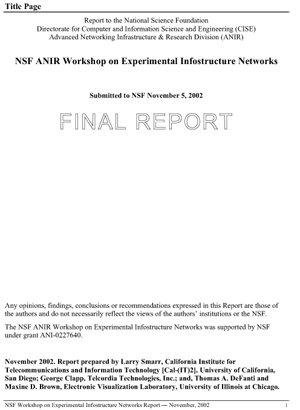NSF ANIR Workshop on Experimental Infostructure Networks
November 5, 2002 -- Today the California Institute for Telecommunications and Information Technology (Calit2) submitted to the National Science Foundation a report emerging from a workshop hosted at UC Irvine last spring by Calit2.
|
The NSF-funded Advanced Networking Infrastructure and Research (ANIR) Workshop on Experimental Infostructure Networks took place May 20-21, 2002, at the Arnold & Mabel Beckman Center of the National Academies of Sciences & Engineering in Irvine. ANIR is part of NSF's Directorate for Computer and Information Science and Engineering (CISE).
Calit2 chair Larry Smarr served as General Workshop Chair. The report was prepared by Smarr, George Clapp of Telcordia Technologies, Inc., and Thomas A. DeFanti and Maxine D. Brown of the University of Illinois at Chicago's Electronic Visualizatoin Laboratory.
The report submitted to NSF gathered the opinions and recommendations of a dozen key corporate technology leaders regarding the future of advanced research and education networks. In particular, the focus was on Experimental Networks as differentiated from Operational Research (i.e., Production) and Research Networks. Also attending were NSF personnel who fund advanced networking and computing, and academics who help build computing and networking information infrastructures (“infostructures” for short).
According to the report, the goal of the May workshop was to answer these questions: "Does the computer and telecommunications industry agree on a need for Experimental Infostructure Networks? If yes, for what reasons, and what should they look like in the near and long term? What roles should industry, government and academia play?"
Workshop attendees concluded that an applications-driven focus for Experimental Networks is of utmost importance. According to the report, the "key concept is not so much the technology research but rather the vertical integration effort (from network to middleware to application to user interface) over multiple application domains. Definition and bounding of the applications and technical communities are also important. The various relationships and purposes of Experimental, Research, and Operational/Production Networks to each other were discussed in detail. The benefits of Experimental Networks to industry were concluded to be several. Foremost is 'lessons learned' from exploring and testing advanced networking concepts through collaborations among researchers from one or more companies and academic organizations who would not otherwise work together; academic organizations with major distributed applications then become company-neutral “meet-me” places. NSF’s essential role is seen by industry to be a supporter of very high-risk experiments staged in more realistic environments than could possibly be set up in a laboratory. Industry benefits from NSF’s investment by reducing their costs and associated risks while garnering early customer validation of ideas, without fear of market embarrassment."
In its conclusions, the report also notes that, "Industry researchers should ideally have opportunities for initial and continuous participation in the program, as well as opportunities for funding, rather than solely have a supplier relationship with academic grantees. For sustainable partnering relationships, companies need to conduct research on topics that are on the critical path to new developments, as well as gain realistic expectations of the benefits that result from their involvement. Workshop participants concluded that private companies and venture capitalists are not generally able to fund Experimental Network infrastructure and research. If the Federal government does not fund Experimental Networks, and does not leverage the installed and emerging base of regional/campus infrastructures, Experimental Infostructure Networks will not be constructed."
For the complete report, including the panel's recommendations to the NSF, click here .
Related Links
NSF ANIR Workshop on Experimental Infostructure Networks Final Report
PDF: ExpInfostructure_Irvine_FINAL_110502.pdf
Media Contacts
Contact: Maxine Brown, maxine@uic.edu

